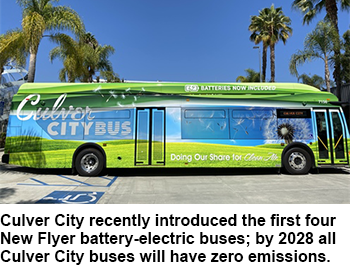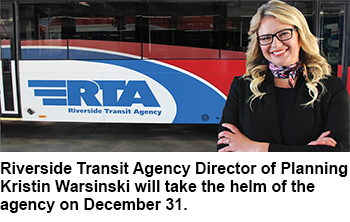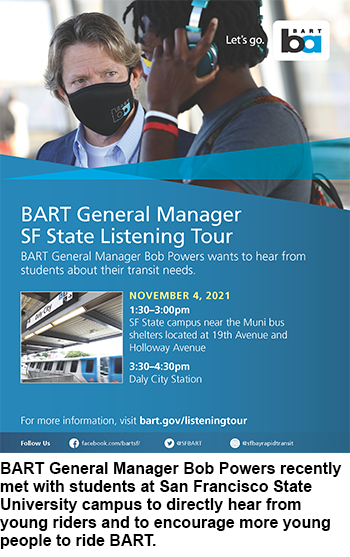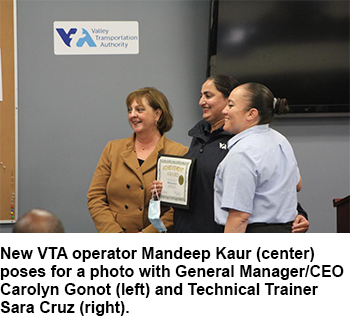The following items are excerpted from news releases issued by California Transit Association members. If you are a member of the Association and would like to submit an item to be considered for inclusion in the Member News Library, please email your press releases to Managing Editor Stephanie Jordan (sjordan@freelancecomm.com). Photos and cutline information with your news release submissions, when possible, are encouraged.
INDUSTRY NEWS 
MOVE Culver City Transforms Downtown Corridor with Expanded Transportation Options
The City of Culver City opened new bus and bike lanes along Culver Boulevard and Washington Boulevard – some of the region's most congested roads – during a grand opening ceremony this month in front of City Hall.
Culver City Mayor Alex Fisch, along with other officials invited the community to ride bikes, e-scooters, Culver CityBus and other transit, including Culver City’s first-in-the-nation low-floor electric minibus, following his brief remarks and a ribbon cutting. City partners micromobility companies Bird and Wheels were at the event to educate the community about using their services. A local DJ provided entertainment, while local eatery Village Well Books and Coffee provided light refreshments.
Culver City has always been a progressive transit city, showing a strong commitment over the years to advance the goals of environmental sustainability. Culver CityBus has played a key role in improving the region’s mobility and air quality by helping to reduce car trips and vehicle miles travelled since 1928.
MOVE Culver City is a mobility initiative of the City Council, under the management of the Transportation Department. This project is being implemented in partnership with Bird and Wheels and will expand the number of ways in which people can get around on city streets with expanded e-scooter share and future e-bikes starting in early 2022. These micromobility options will provide a first-and-last-mile solution by helping to close the gap between Culver CityBus transit stops and final destinations, making it easier than ever to move to, through and from Culver City.
MOVE Culver City also partnered with Sunset Vans to introduce the first-in-the-nation low-floor electric mini-bus. The mini-bus runs every 10 minutes during peak hours and every 20 minutes during non-peak hours. The mini-bus will take a circulating route that moves Culver City residents to and from the E-Line’s Culver City station through Downtown Culver City and the Culver City Arts District. The circulator service will be free to ride for the first six months of the pilot phase.
“We are creating the infrastructure to support public transit, pedestrians, and cyclists, which will reduce both emissions and traffic," said Culver City Chief Transportation Officer Rolando Cruz. “We are committed to enhancing the quality of life within our community through the adoption of sustainable mobility solutions. Culver City recently introduced the first four New Flyer battery-electric buses and is home to the first electric mini-bus in the U.S. By 2028, all Culver City buses will have zero emissions.”
Bay Area Transit Agencies Cheer Infrastructure Bill Passage
Transportation agencies from around the Bay Area celebrated the signing of the Infrastructure Investment and Jobs Act, thanking President Biden and Transportation Secretary Pete Buttigieg, as well as California’s federal delegation for their leadership and support. The bill will provide nearly $1 trillion in infrastructure funding that could potentially go to support dozens of projects and programs that help to keep the region moving.
“Electrification will transform Caltrain, replacing 75 percent of the aging diesel fleet with high-performance state of the art electric train, but this funding will allow us to take the next step and finish the project by 2024,” said Caltrain’s Acting Executive Director Michelle Bouchard. “Additional federal support will help get us to a fully zero emission service and will allow the agency to realize its 2040 Service Vision goal of running 8 trains per hour in each direction, which would carry the equivalent of 5.5 lanes of freeway traffic. It also presents a new opportunity to support local communities pursuing grade separations throughout the corridor, a vital safety measure that will prevent traffic bottlenecks, as well as creating world class transit stations in San Francisco and San Jose that are better integrated into the communities they serve.”
“This is a great day for public transportation,” said San Mateo County Transit District General Manager/CEO Carter Mau. “Bus agencies throughout California have committed to adopting fully zero emission fleets by 2040, and this bill offers a means of funding that ambitious goal. We are all one step closer to cleaner, greener bus service that is vital in the fight against climate change.”
“The infrastructure bill is a once-in-a-generation investment in things that matter to our riders: reliability, frequency and accessibility,” said San Francisco Bay Area Rapid Transit Agency General Manager Bob Powers. “It also benefits Bay Area residents who don’t necessarily ride BART by creating the opportunity for jobs with good pay. Our Congressional delegation and the Biden-Harris administration are to be applauded for their unwavering commitment to public transportation.”
FTA formula funds within IIJA are expected to support BART’s Train Control Modernization Program to increase frequency through the Transbay Tube, to enhance BART’s efforts to rebuild tracks, electrical cabling and other critical infrastructure and to improve accessibility for those with disabilities, including modernizing elevators.
“VTA will use this critical funding to help create jobs to build projects like the Silicon Valley BART Extension, to help meet the State of California mandates for clean energy fleets by 2040, and provide electric charging infrastructure at our three bus yards,” said Santa Clara Valley Transportation Authority General Manager/CEO Carolyn Gonot. “We have a responsibility to build a greener transportation network in Santa Clara County and this funding will help us do that.”
"We have worked for two decades to ensure zero-emission is more than a test of innovation, but achievable delivery of service aboard our expanding fleet of both hydrogen fuel cell and battery electric buses,” says Alameda-Contra Costa Transit District General Manager Michael Hursh. “It is now our hope that this historic bill will accelerate AC Transit’s mission to eliminate tailpipe emissions from every bus by 2040, by funding infrastructure improvements like large-scale depot bus charging, faster and more efficient hydrogen fueling pumps, battery storage and microgrid systems for resilient operations, and renewed maintenance facilities to accommodate these new zero-emission bus technologies.”
“With this monumental help from our state and federal leaders, we now have the much needed funds to better our critical assets, transportation system and agency infrastructure,” said Jeffrey Tumlin, San Francisco Municipal Transportation Agency Director of Transportation. “These dollars will directly fund the programs and projects our community values most including State of Good Repair, Complete Streets Investments, Fleet Replacement, Safe Streets for All Program, Overhead Lines, Historic Fleet Rehabilitation and Repair and Vision Zero.”
“Overall, it is hard to overstate the significance of this legislation to the Capitol Corridor and the nation’s passenger rail industry,” said Rob Padgette, Managing Director for the Capitol Corridor Joint Powers Authority. “Historically, we have relied almost entirely on funds from the State of California to invest in passenger rail improvements. With IIJA, we can now partner with the Federal government to dramatically enhance our service. For our riders, this legislation will mean stronger rail connections throughout the Northern California megaregion; improved safety and reliability; and an overall better customer experience.”
California will receive approximately $9.5 billion for public transportation and $47.2 billion for roads, bridges and ports from the bill. An additional $600 million will be available to prepare transportation system for extreme weather, including drought and wildfires. The bill also includes an approximately $475 billion reauthorization of the core federal transportation program for the next five years, a 56% increase over the current Fixing America’s Surface Transportation (FAST) Act. The new five-year federal program should provide approximately $4.5 billion to the Bay Area through established formulas, which among other things will help to fund the purchase of new electric buses.
BART to Reopen Long-Closed Restrooms at Two of the System’s Busiest Stations
San Francisco Bay Area Rapid Transit Agency is poised to reopen restrooms that have been closed for 20 years at some of the system’s busiest stations. The BART Board, at the request of Vice President Rebecca Saltzman, heard an update on the status of improvements to these closed restrooms and the plan from General Manager Bob Powers to reopen them for the use of riders.
The first restrooms will be reopened this February at the 19th Street Station in downtown Oakland and the Powell Street Station in downtown San Francisco. Those restrooms will be staffed with attendants for at least the first three months to promote safety and proper use.
“BART has worked hard during the pandemic to improve the system to encourage the return of our riders. A key part of that effort is to make the system more user-friendly and one of the most important steps we can take toward that goal is the reopening of long-closed restrooms,” said Powers. “Our goal for this round of restroom reopenings is to learn lessons and guide additional openings. We will actively engage with the BART Accessibility Task Force, as well as design consultants to ensure we are upgrading these restrooms to make them safe, clean, and available to all.”
Restrooms at 10 of BART’s underground stations have been closed since 9/11 because of safety concerns. Now BART is moving forward with plans to reopen restrooms once plumbing, electrical, ventilation, access, and safety improvements are made. The new restrooms at 19th Street and Powell are designed like the new restrooms at El Cerrito del Norte Station, which were reopened in 2020 after the completion of a station modernization project. Those restrooms were brought fully into code compliance and upgraded with an improved ventilation system.
The initiative brings new funding challenges, but BART staff is working to identify potential sources of capital support. BART staff has conducted a detailed assessment of the conditions of the closed restrooms for access, repair, and security needs. Some restrooms require more renovations than others. BART hopes to identify funds to reopen restrooms at the Lake Merritt and Montgomery Street stations before summer next year.
Based on the assessment and depending on the success of other reopened bathrooms there is potential to reopen upgraded restrooms at Downtown Berkeley and Embarcadero in fiscal year 2023. The remaining underground restrooms require significant funding and construction including designing and building brand new bathrooms at 16th and 24th Street Mission Stations.
The estimated funding needed to reopen all of the closed restrooms is approximately $14 million through fiscal year 2026, none of which has been identified.
CityBus Initiates Plan for Zero-Emission Fleet by 2040
Santa Rosa CityBus has purchased four battery-electric buses (BEBs) and will install six single-port Electric Vehicle (EV) charging systems initiating its plan to transition to a fully zero-emission fleet by 2040. The new all-electric zero-emission buses, scheduled to arrive summer 2022, will remove four 40-foot diesel-fueled transit buses from circulation. The replacement reduces ongoing fuel and maintenance costs, and the City of Santa Rosa’s carbon footprint.
Transitioning CityBus’ fleet of 29 buses to new zero-emission buses will occur gradually over the next several years in compliance with the California Air Resources Board’s Innovative Clean Transit Rule (ICT) adopted in 2018. This rule requires all public transit agencies in the state to adopt and implement plans to transition their fleets to zero-emission buses by 2040. ICT also states that all new bus purchases in California must be zero-emission by January 1, 2029.
The four Proterra zero-emission buses were purchased with funding awarded through two $2.9-million competitive grants from the Federal Transit Administration (FTA) in 2017/2018. To optimize the funding award, CityBus will lease the battery systems for the BEB’s, a strategy that made the purchase of four zero-emission buses possible. The EV charging systems will be installed in the City’s Corporation Yard by January 2022 with funding through the PG&E EV Fleet program. In exchange for PG&E upgrading the power supply and connecting electrical wires to the EV charging systems, CityBus is committed to purchasing nine BEBs and installing five dual port chargers by 2025.
CityBus is making plans already for future bus purchases. During the October 26, 2021 Santa Rosa City Council meeting, Council approved staff to submit an application to the FTA for grant funding to replace six 2011 buses with six new all-electric zero-emission buses. Council also approved installation of additional EV charging systems that will be needed to support these additional buses.
Reducing the transportation sector’s reliance on petroleum is a key component of a statewide effort to reduce greenhouse gas emissions, strengthen the economy, and improve public health and the environment. According to the Sonoma County Regional Climate Protection Authority’s analysis in the Climate Action 2020 plan, on-road transportation is responsible for generating the majority of greenhouse gas emissions within Sonoma County. Although the most significant portion of Sonoma County on-road transportation emission is attributed to single occupancy vehicles, replacing a CityBus diesel bus with a zero-emissions bus is the equivalent of replacing five personal automobiles on Sonoma County roads. Ultimately, BEB “well to wheel” emissions depend on how electricity for the grid is produced. With the inception of Sonoma Clean Power in 2014 and the City’s commitment to Evergreen power, the 100 percent renewable (84 percent geothermal & 16 percent solar), locally produced energy, and a shift to BEBs allows for a reliance on a portfolio of cleaner low emissions electricity.
Metrolink and Moovit Partner to Provide Southern Californians with an Easier Commute
Metrolink announced this month a marketing partnership with mobility solutions company Moovit to help riders calculate the best route for each journey. The Moovit app uses official, as well as crowdsourced, information to offer users quick, convenient trip planning options including Metrolink, light rail, buses, scooters and on-demand ride services, such as Uber and Lyft.
Moovit users receive current information so they know exactly when their bus or train is arriving, a Live Directions feature with Get Off Alerts to provide step-by-step guidance for the entire journey, and Service Alerts so they can avoid delays and better-plan their journey.
Moovit also incorporates accessibility features to help persons with disabilities use public transportation easily. The app has screen reading features for low vision users, including TalkBack/VoiceOver capabilities, identifies wheelchair-accessible routes and stations, and calculates step-free routes. Moovit’s app is also designed with optimized menus and buttons for those with hand-motor disabilities.
SacRT Offers Free Rides on Small Business Saturday
SacRT offered free rides to support Small Business Saturday on Saturday, November 27. Riders could take SacRT bus and light rail FREE all day with a free ride flyer they could print or screenshot.
The free ride on SacRT provided riders a way to support Small Business Saturday, as well as an opportunity to reduce the rider’s carbon footprint by going car-free.
SamTrans and San Mateo County Transportation Authority Host Autonomous Vehicle Workshop
San Mateo County Transit District and the San Mateo County Transportation Authority (TA) hosted a workshop on the future of autonomous vehicles in San Mateo County. The webinar provided an overview of current autonomous policy framework, and an opportunity to learn about available technologies and potential policies.
With autonomous vehicle technology advancing, there are a great number of policies that will need to be implemented for these vehicles to become street-legal. Collaboration is necessary for the companies that build the vehicles, the public agencies that manage the roads, and the transit agencies that operate in the same space to ensure these vehicles can operate safely and effectively as they become available.
Speakers at the event included University of San Francisco Professor William Riggs, Zoox Chief Safety Innovation Officer Mark Rosekind, M. Imran Ali of Via Transportation, Jose Alvarado of Cruise, and representatives from public agencies including Santa Clara Valley Transportation Authority, the Contra Costa Transportation Authority, the Utah Transit Authority, and the Connecticut Department of Transportation.
OCTA Board Approves Contract to Maintain Orange County’s 5,400-plus Bus Stops
The Orange County Transportation Authority Board of Directors recently approved a contract to help maintain bus stops across Orange County, ensuring riders get updated, reliable route information wherever they board an OC Bus.
The OCTA board approved a $1.6 million contract with ShelterClean Services, Inc. for a three-year term beginning Dec. 1, with the option to extend the contract through 2028. OCTA currently has 58 bus routes operating across Orange County and into neighboring counties, with a total of 5,480 bus stop locations. Some express bus routes have as few as 10 stops, whereas the more well-travel routes in areas of core ridership have as many as 150 stops per route.
OCTA installs and maintains posts and signage identifying the route information at each stop, as well as maintaining solar lighting so the stops can be seen at night. OCTA works with individual jurisdictions to determine the most efficient placement of bus stops for the highest level of customer service.
Individual cities and the county are responsible for providing passenger amenities, such as benches, shelters and trash receptacles, at individual stops, as well as the upkeep of those shelters. OCTA issues approximately 1,600 work orders every year for a variety of issues, including graffiti removal, replacing damaged signs and posts, trimming trees, painting red curbs, moving benches, and repairing solar lights.
Service requests for trash removal and other shelter maintenance are coordinated with the jurisdictions responsible for the bus shelters.
The OCTA contactor performs preventative maintenance at each bus stop periodically, including cleaning, replacing and repairing OCTA-owned hardware. In addition, OCTA issues work orders for each of OCTA’s service changes, typically three each year. The work orders vary in scope and include installing or removing bus stop signs, posts, hardware, informational materials, and route schedules. Depending on the scope of a service change, 3,000 to 4,000 informational pieces may be replaced to support a single service change.
To save taxpayer money, OCTA began contracting bus stop maintenance in 1994. ShelterClean, based in Los Angeles County, has extensive experience in Los Angeles, Orange and Riverside counties.
TRANSIT PEOPLE AND HAPPENINGS 
Riverside County Native Kristin Warsinski to Lead Riverside Transit Agency
Kristin Warsinski will be Riverside Transit Agency’s (RTA) new Chief Executive Officer, filling a position currently held by Larry Rubio, who has held the title since 2001.
The RTA Board of Directors unanimously approved Warsinski as the Agency’s new leader during their meeting on October 28. Warsinski officially assumes her new role on December 31.
Warsinski will take leadership of an organization that looks to rebound from the pandemic by building ridership, continuing to make good use of taxpayer dollars, focusing on equitable service and fostering healthy bonds with the community. Several ambitious projects are already in the works, including the creation of a transit hub in Riverside, the launch of microtransit service in San Jacinto and Hemet, and the transition to a zero-emission bus fleet.
“I am truly honored and humbled to lead the best transit agency in the nation,” Warsinski said. “RTA has a proud history of serving the community and providing world-class transportation for the people of Riverside County. I look forward to building on that momentum and partnering with our talented employees and community partners to provide an exceptional service that our customers can be proud of in the weeks, months and years ahead.”
A Riverside County native, Warsinski has more than a decade of service in the public transit industry. As RTA’s director of planning, she oversaw the development of RTA’s routes and schedules, short-range transit plans, and grant applications from federal, state and local sources. Warsinski also spearheaded RTA’s Zero-Emission Bus Rollout Plan, an ambitious blueprint for converting RTA’s entire fleet to hydrogen-powered buses. She also led the Agency through the Transportation Development Act and Federal Transportation Administration triennial audits, both of which resulted in perfect reviews, ensuring the Agency’s ongoing competitiveness in acquiring future grant money.
Since her arrival to RTA more than six years ago, Warsinski has also served as grants manager and planning and programming specialist. Prior to RTA, she held various administrative positions with the City of Beaumont. She has a master’s degree in public administration from California Baptist University and a bachelor’s degree in biological sciences from UC Irvine.
 BART GM Listening Tour with San Francisco State Students to Boost Transit Ridership
BART GM Listening Tour with San Francisco State Students to Boost Transit Ridership
BART General Manager Bob Powers recently met with students at San Francisco State University campus about their transit needs and to hear their ideas to encourage more young people to ride BART. The visit to the San Francisco State campus gave Powers the chance to talk with students about how transit can best serve them. The visit to SF State came just before the General Manager continued his Listening Tour at the Daly City BART Station, timed to catch students passing through the station on their way home.
“Students are playing an important role in BART’s recent ridership increase,” said Powers. “It’s important for me to hear directly from young riders to learn more about what’s working with our service and to generate ideas for ways we can improve.” Powers relaunched his Listening Tour in August as many riders were returning to transit with the goal of visiting BART’s 10 busiest stations since the pandemic. During his recent station visits Powers has noticed the large number of students using the system. That’s what is prompting him to do additional direct outreach to young riders. In addition, Daly City Station is currently BART’s 11th busiest station.
San Francisco State is a great example of a school taking a transit-first approach to access. Their Gator Pass program is a model for how other schools can fund BART discounts for students. The Gator Pass allows students to get 50 percent off all BART rides to or from the Daly City Station.
BART worked with student leaders from San Francisco State to plan the event and the BARTmobile, often featured in local parades, was also on campus during the event.
New Class of Bus Operators Helps VTA Address Critical Shortage
When the latest class of Santa Clara Valley Transportation Authority (VTA) bus operators graduated from their 9-week training program, Eric Shaunce was keenly aware of one irony. The bus he used to seek shelter on when he was homeless and addicted to drugs is now the bus he proudly drives in his 15th year of sobriety.
“I used to ride the 22 all day so I could stay dry when I was in my addiction,” said Shaunce, just before his graduation as a VTA Bus Operator. “Last Friday, I got to drive the 22. I have a little bit more compassion…for the less fortunate because I used to be that person.”
"Used to" being the operative words. October 9 was the 15th anniversary of the day he says he “made a choice to get clean.” Shaunce has had a few different jobs since then, mostly with drug rehab organizations, trying to help others follow in his footsteps to successful sobriety. But he says he came to VTA for a “career.”
“I am so grateful for the opportunity to work for VTA. I shared with the students in class that they needed to study and do whatever it took to pass the test and complete this course, so they could have a career and not have 500 jobs like I did in my lifetime.”
Shaunce is one of 27 new operators about to take to the streets, helping VTA fill a critical shortage of operators over the past two years. With a national labor shortage taking shape since the start of the COVID-19 pandemic, VTA is not alone in looking for more people to hire. Transit service affected during the height of the pandemic is building back little-by-little, but service frequencies will not be back to normal until enough operators can be hired to fill close to 70 vacancies.
In keeping with an agency goal to hire more women in non-traditional jobs, 12 women joined the agency as bus operators in the past two trainee graduating classes.
Bus operator is an entry-level position with a starting salary of $42,000, no prior experience necessary, training is provided, with an opportunity to earn up to $70,000 after four years. VTA also offers generous benefit packages, as operators are members of the Amalgamated Transit Union (ATU) Local 265. As part of VTA training programs, operators are paired with mentors through the Joint Workforce Investment program, a collaboration between ATU and VTA, which helps new employees successfully navigate the job and helps provide upward mobility within the agency.